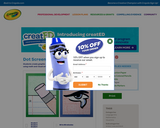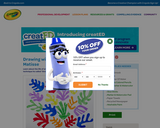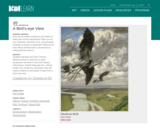
In this lesson, students explore the artwork of Georges Seurat and create a masterpiece.
- Subject:
- Arts Education
- Material Type:
- Lesson Plan
- Provider:
- Crayola
- Date Added:
- 06/14/2018

In this lesson, students explore the artwork of Georges Seurat and create a masterpiece.

In this lesson, students examine Roy Lichtenstein's artwork. Students will then either replicate a Lichtenstein artwork or create an original one in his style.

In this lesson, students examine Henry Matisse's artwork, making note of how his art changed throughout his career. Students will then work collaboratively to either replicate a Matisse artwork or create an original one in his style.

Students will use their animal sketches and notes from the last art class to generate ideas and create a 3-D paper hand puppet of the animal they chose to study. Teacher will demonstrate a variety of paper sculpture and folding techniques. Students will use these paper sculpture techniques and choose contrasting colors/shapes to create an expressive hand puppet with big, bold, and expressive elements of art. Some recycled papers will be used to teach recycling and conserving of our paper resources. Fraction folding techniques/terminology will integrate math into this art lesson. This lesson was developed by Nancy McGuire as part of their completion of the North Carolina Global Educator Digital Badge program. This lesson plan has been vetted at the local and state level for standards alignment, Global Education focus, and content accuracy.

Students will collaborate in groups to plan and present a puppet show using their hand puppets and illustrated animal booklets. They will share what they have learned about animals around the globe with their classmates through these puppets and illustrated booklets. Groups will be assigned by the teacher according to their animals' regions/habitats of the world. This lesson will use all the information learned and products created during this unit called "Learning About Animals Around the Globe". This lesson was developed by Nancy McGuire as part of their completion of the North Carolina Global Educator Digital Badge program. This lesson plan has been vetted at the local and state level for standards alignment, Global Education focus, and content accuracy.

Students will learn about animals around the globe through growing awareness, research, and sharing of their perspectives about animals and their particular habitats. In this first introductory lesson, students will listen to discussion, view images, and then research animals from various regions of the world using internet images and an assortment of animal books provided at their work tables. After the class discussion and individual study of resources, students will choose one animal as a focus and become familiar with its physical characteristics, habitat, and fun facts to share during a future lesson. Students will then use drawing paper and pencil to render quick sketches of their animal showing its physical characteristics. These sketches will be used during the next art lesson when students will create a 3-D paper puppet of their animal. This lesson was developed by Nancy McGuire as part of their completion of the North Carolina Global Educator Digital Badge program. This lesson plan has been vetted at the local and state level for standards alignment, Global Education focus, and content accuracy.

Students will use their notes, sketches, and paper hand puppet from the previous lessons in this unit to write and illustrate a booklet about their animal and the global region where it lives/lived. Students will understand the correlation between art and literacy as they create a short booklet about their animal and its habitat. Students will prepare to share these short stories with their peers in the form of a collaborative puppet show when they have completed their illustrated booklets. This lesson was developed by Nancy McGuire as part of their completion of the North Carolina Global Educator Digital Badge program. This lesson plan has been vetted at the local and state level for standards alignment, Global Education focus, and content accuracy.

Students will learn and apply the concepts of visual stimulus and watercolor resist as they draw and paint organic shapes they have photographed while on a nature walk. Students will incorporate their understanding of science skills in applying their knowledge of plant parts their original creations.

Students will learn the concept of and procedure for changing color value. They will then apply these new understandings as they create their own abstract scribble design and use a monochromatic palette to paint their design with watercolor paint.

Students will delve into Hans Thoma’s Wondrous Birds to discover an aerial perspective and learn to see more deeply. Using dance, English language arts, science, theatre arts, visual arts, and poetry, they will explore landforms and bodies of water from a bird’s-eye view.

Students will brainstorm a list of adjectives to describe two early photographs called "cyanotypes." Next they will create their own cyanotype photograph. Students will then write original poetry using the previous list of adjectives to describe their own nature-inspired cyanotype photograph.

Piccassohead is a digital tool that allows users to create their own masterpieces using famous features drawn by Picasso. Use as a tool for exploration, creation, collaborative work, and application of prior knowledge. Imitate the artistic style of a Spanish painter.

Students will construct their own "pieces of the pie" using concepts of primary, secondary and intermediate color.

Students will understand the difference between a sculpture and a drawing or painting, understand the meaning of the word silhouette and will create a simple silhouette of any animal or object they choose and use that drawing to create a sculpture piece which is mounted to a wooden base.

This free website provides more than 600 adaptable lesson plans written by teachers in collaboration with the Denver Art Museum for more than 130 objects from the museums world-class art collection. Lesson plans and resources focus on inspiring students to think and problem-solve creatively. Organized in an easy way so that teachers can pick the topic they would like to explore or enhance, then use works of art to teach that subject.
High resolution images are included. Museum visits are not necessary to implement lesson plans. Includes professional and student development tools such as teacher workshops and webinars, virtual classroom courses, career videos, educator blogs and creativity tools. Easy for teachers in language arts, social studies and visual arts to provide a curriculum rooted in the arts while also meeting 21st Century Skills.

Students will learn the value of and how to incorporate symbolism as a means of expressing personal meaning as they create an original family tree which represents their family and culture. They will incorporate language arts skills through expressing their personal story in writing a composition, as well as history as they orally express the ideas they have set forth both in their symbolic rendering as well as their writing composition.